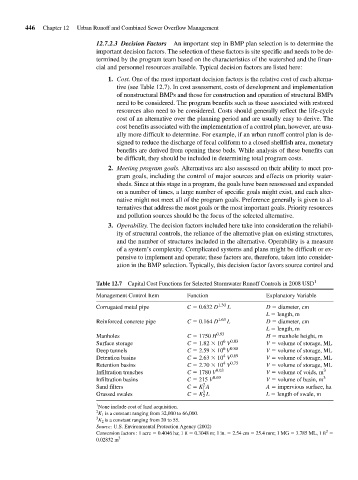Page 488 - Fair, Geyer, and Okun's Water and wastewater engineering : water supply and wastewater removal
P. 488
JWCL344_ch12_398-456.qxd 8/4/10 9:37 PM Page 446
446 Chapter 12 Urban Runoff and Combined Sewer Overflow Management
12.7.2.3 Decision Factors An important step in BMP plan selection is to determine the
important decision factors. The selection of these factors is site specific and needs to be de-
termined by the program team based on the characteristics of the watershed and the finan-
cial and personnel resources available. Typical decision factors are listed here:
1. Cost. One of the most important decision factors is the relative cost of each alterna-
tive (see Table 12.7). In cost assessment, costs of development and implementation
of nonstructural BMPs and those for construction and operation of structural BMPs
need to be considered. The program benefits such as those associated with restored
resources also need to be considered. Costs should generally reflect the life-cycle
cost of an alternative over the planning period and are usually easy to derive. The
cost benefits associated with the implementation of a control plan, however, are usu-
ally more difficult to determine. For example, if an urban runoff control plan is de-
signed to reduce the discharge of fecal coliform to a closed shellfish area, monetary
benefits are derived from opening these beds. While analysis of these benefits can
be difficult, they should be included in determining total program costs.
2. Meeting program goals. Alternatives are also assessed on their ability to meet pro-
gram goals, including the control of major sources and effects on priority water-
sheds. Since at this stage in a program, the goals have been reassessed and expanded
on a number of times, a large number of specific goals might exist, and each alter-
native might not meet all of the program goals. Preference generally is given to al-
ternatives that address the most goals or the most important goals. Priority resources
and pollution sources should be the focus of the selected alternative.
3. Operability. The decision factors included here take into consideration the reliabil-
ity of structural controls, the reliance of the alternative plan on existing structures,
and the number of structures included in the alternative. Operability is a measure
of a system’s complexity. Complicated systems and plans might be difficult or ex-
pensive to implement and operate; these factors are, therefore, taken into consider-
ation in the BMP selection. Typically, this decision factor favors source control and
Table 12.7 Capital Cost Functions for Selected Stormwater Runoff Controls in 2008 USD 1
Management Control Item Function Explanatory Variable
Corrugated metal pipe C 0.632 D 1.30 L D diameter, cm
L length, m
Reinforced concrete pipe C 0.164 D 1.63 L D diameter, cm
L length, m
Manholes C 1750 H 0.93 H manhole height, m
6
Surface storage C 1.82 10 V 0.83 V volume of storage, ML
6 0.80
Deep tunnels C 2.59 10 V V volume of storage, ML
4
Detention basins C 2.63 10 V 0.69 V volume of storage, ML
4
Retention basins C 2.70 10 V 0.75 V volume of storage, ML
Infiltration trenches C 1780 V 0.63 V volume of voids, m 3
Infiltration basins C 215 V 0.69 V volume of basin, m 3
2
Sand filters C K 1 A A impervious surface, ha
3
Grassed swales C K 2 L L length of swale, m
1
None include cost of land acquisition.
2
K 1 is a constant ranging from 32,000 to 66,000.
3
K 2 is a constant ranging from 20 to 55.
Source: U.S. Environmental Protection Agency (2002)
3
Conversion factors : 1 acre 0.4046 ha; 1 ft 0.3048 m; 1 in. 2.54 cm 25.4 mm; 1 MG 3.785 ML, 1 ft
0.02832 m 3

